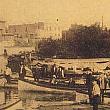
Building a Jesiek Co. Boat

A family member describes the way Gus designed his boats. “The design technique amounted to shaping a block of wood to a desired shape and then taking the lines from the model and ultimately building a boat in the shape of the model. The block of wood was no ordinary block. It had been carefully glued together from pieces of even dimension so that water line, stations and architectural points could be identified. This was a common device for boat building in those days.”
The following is excerpted from the Jesiek Boat Catalog ca 1908
General Construction
The frames are fastened to the forms, the boats lying keel up. When the planks are nailed to the frames, they are forced tightly against the solid form—they take its shape. Consequently one side of a Jesiek hull is exactly like the other; there is no variation whatever, and a Jesiek even up to two thousand pounds weight will balance itself on a three inch keel, resting on a level surface. Long clear lumber is used, the butts are well distributed. The small oak frame will not stand two rows of nails; hence the butts are placed between frames with oak reinforcements. Never buy a boat with butts on frames. These points are of interest to you who wish to own a boat. They make for staunchness, durability, seaworthiness and satisfaction.
Stem, Stern, Post and Keel
Beginning with the construction of the stem and stern post, deadwood and keelson are of straight-grained white oak, the strongest, roughest wood for shipbuilding ever known. From the time when nations put their fortunes into the keeping of the oaken walls of their ships of battle, no good substitute has been found for the HEART OF OAK in the making of boats.
Keels are fastened to stem, deadwood, etc. with bolt having nuts on both ends, the outer nuts being countersunk into the heavy wood.
Our keels are where possible, laid in one length of timber, but where this is impracticable, we use a long scarf joint CAREFULLY LEADED before fastening together.
All joints in our construction are carefully paved with white lead before being fastened, and with this treatment there is very little chance of the water having any effect on them.
Stopwaters are used in all joints below the water line.
Frames
Frames, or ribs, are of small-growth white oak or rock elm, stem bent to shape, closely fitted to the keel and fastened there with binders. Frames are spaced on the keel five to nine inches between centers, the space being governed by the size of the boat and the thickness of the planking used.
SHAFT LOG is molded from Northern white oak, carefully bored and fastened with ---bolts from top of keel to bottom of skag.
KEELSONS and engine foundation timbers from Northern white oak in long length, which when bolted to the main keel, forms a truss throughout the entire length of the boat, which will practically eliminate any and all vibration caused from the operation of the machinery.
Planking
In modern pleasure craft where lightness is necessary, there is but one wood in which all desirable qualities are combined—red cypress, from Louisiana, so the scientists tell us is, speaking botanically, of the same species as that from which mummy cases were made. If you doubt its durability, go to the nearest museum where you will find mummy cases of red cypress which have withstood the ravages of time for four thousand years. Red cypress planking is used on all Jesiek launches. We buy the best quality only, and that in large quantities so that we may have time to air-dry it. It is never kiln-dried. We AIR-DRY all lumber.
Caulking
All seams are forced open with seam burnisher, the paved with the best quality of lead paint and hand caulked with No. 1 quality caulking cotton. Seams are again paved with paint and then filled with flush with marine putty and all sanded smooth to an even surface.
Decks
Deck beams, breast hooks and coming knees are sawed to shape. Plenty of crown is given to the deck so that water will shed freely. Decks are laid parallel to the keep and are mode from narrow strips securely fastened. Covering boards are sawed to shape of plank shear and sections secured by means of screws.
All joints are calked and paved with putty colored to match the finish. The coaming is steam bent and fitted to shape; of good substantial thickness and joints a perfectly reinforced.
Paint Work
All Jesiek boats are given three coats of good paint inside the lockers, underneath the floor and underneath the decks. All panel work, decks, coaming, shear strake, moldings, etc. are made from white oak. White oak is desirable, weathers well, and presents a handsome appearance, and is in every way very satisfactory. White oak parts are filled with richly colored fillers, carefully made to bring out the beauty of the wood. They then receive three coats of the highest quality of spar varnish, each coat being rubbed down before the next is applied.The exterior of the hull receives four coats of best lead white paint.

 facebook
facebook


